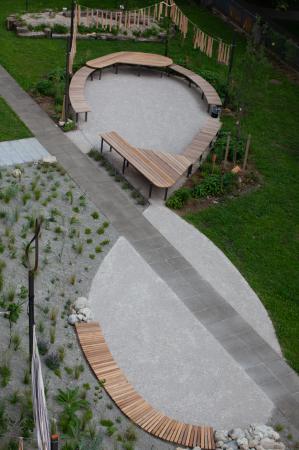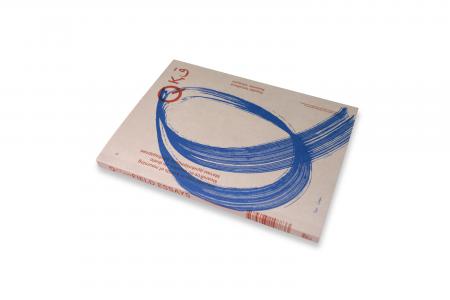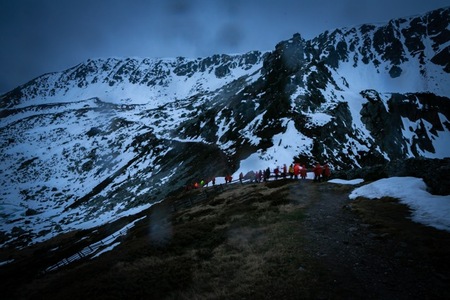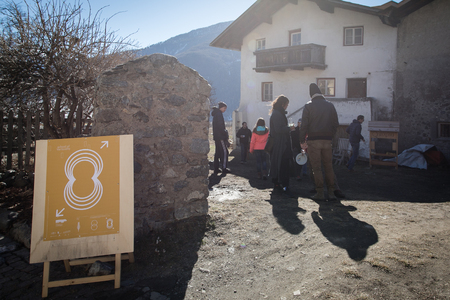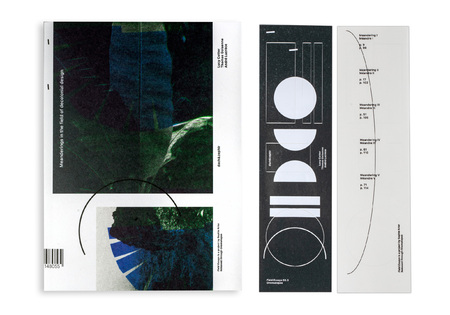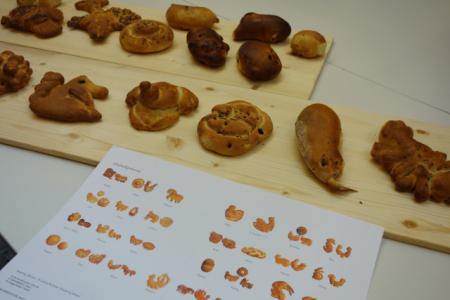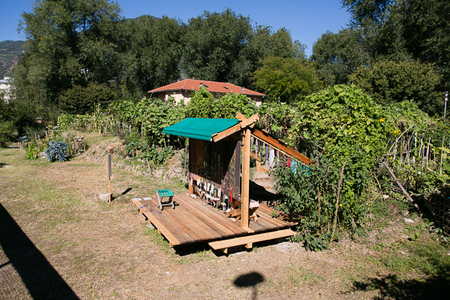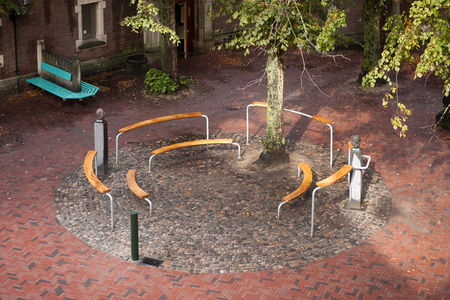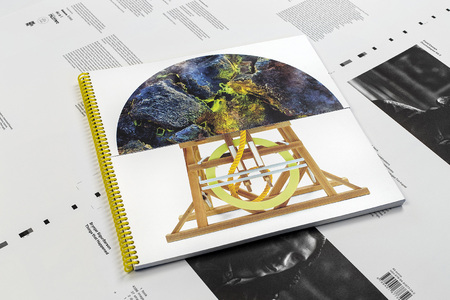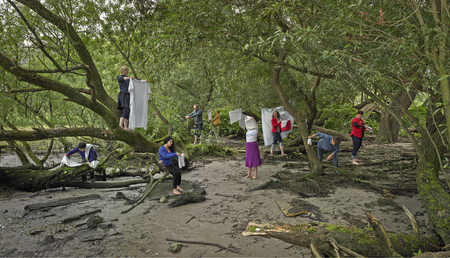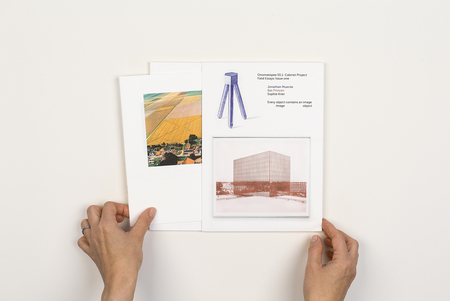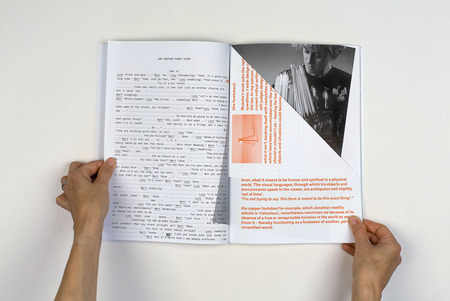-
info
What can we learn from life cycles on a school meadow? From 2022 to 2024, a series of semester-long artistic-pedagogical processes was launched on the grounds of HLW Bad Ischl and an outdoor learning space grew. Together with Daniela Brasil, I developed the Garden of Moving Times there in dialogue with teachers, students and related experts and initiatives. The project was produced by <rotor > Centre for Contemporary Art in the context of Bad Ischl Salzkammergut Cultural Capital of Europe 2024. Rooted in the concept of ‘care’, which theoretically plays a central role in education at HLW (a secondary school for economics, social management and care), the Garden of Moving Times is about reclaiming our relationship to the earth - time understood as time to ground and replenish ourselves - as opposed to time as a measure of production. In the garden, broken relationships with plant, animal, mineral and ancestral worlds can be restored. What is school time, body time, garden time? Underlying the design is the intention to take time to care and heal by embracing natural time cycles. photo Pia Fronia
-
info
Since 2008, Sophie Krier's publication series Field Essays brings together thinkers and practitioners from artistic and scientific fields of knowledge to make complex issues palpable. In this fifth issue, Krier explores with filmmaker Saodat Ismailova (Uzbekistan) and decolonial thinker Rolando Vázquez (México) what their cultures can learn from each other in mourning and healing the triple colonial wound of timelessness, earthlessness and worldlessness.
-
In Search of the Pluriverseinfo
Making Radio, hosted by Sophie Krier and Erik Wong since 2018, is a (live) podcasting programme about what we make, why we make it, who ‘we’ are, and in the end or in the beginning, what gives and deprives us, and others, of humanity. Making Radio inserts humanity and depth in playful talks on what it means to be human today: what made us into what we are, what moves us, what we can set in motion as terrestrial beings. But also what escapes us, scares us, and where we fail, again and again, beautifully. In 2020 Wong & Krier were asked by Het Nieuwe Instituut to curate the first edition of the Travelling Academy. In the light of the current pandemic and resulting travel restrictions, Wong & Krier start their quest for the pluriverse from home with Arturo Escobar’s 'Designs for the Pluriverse' 2018 book in hand. Through short, animated talks with thinkers and makers from different domains, they dive into four urgent themes taken from the book: autonomy, world-making, the vernacular, and (de)futuring. Uploaded mp3: Warming up to the Pluriverse #1 : On Becoming Networks, with Joke Robaard.
-
info
Unfinished document of life lines, knotted at the Indeterminacy Festival 2018 Buffalo NYC, curated by Stanzi Vaubel. Supported by [NA!] Project and Techne Institute. Coordinated by Frank Bauchard. Shot in 3:4 with a handheld, nicely portable Lumix, which my dad gave me. The lecture, which preceded the lifeline making, explored the ancestral gestures of sowing and harvesting as analogies for values and attitudes, which in my eyes need to be nourished and defended. To make ourselves available for whatever work needs to be done, is one such attitude, which we need to train, again and again. To pay attention to what is (rather than how we would like things to be), and to learn to mend missing links is another. All around us are loose threads, waiting to be knotted up and woven into replenished stories of courage. Stories that are able to do justice to the multiple interspecies trajectories that continuously unfold through and around us. We live in a world of abundance, a world thriving with possibilities; yet the dominant view in Global North societies is one grounded in scarcity and fear. Can we reconnect with the losses we encountered, and through new mourning and celebration rituals, seed collective imaginaries for living together? The lifelines made their way to Europe, South Tyrol, and became part of School of Verticality, an ongoing inquiry into the depths of our memory. www.sophiekrier.com
-
info
For its concluding episode in South Tyrol, School of Verticality explored the potential of weaving borders to challenge the understanding, in Western modernity, of our belonging to certain spaces or identities: land, nation-states, nature, culture, species, gender. In an age when walls are erected and separation overshadows coexistence, frontiers have become more than cognitive or political symbols. Some are displacing life, but sometimes life is displacing them. In this context, I proposed to reinvent Allan Kaprow’s happening OVERTIME, realized only once in Spring 1968 at University of California, San Diego. In this work, the artist gives instructions to move an 200 feet (+- 50 m) snow fence over a distance of 1 mile (+- 1,5 km) in the course of one night. Like many other happenings, OVERTIME develops Kaprow’s guiding principle of blurring boundaries between art and life. The piece was never re-invented. photo by Joerg Oschmann
-
info
The second episode of School of Verticality, Seeding Stories, took place on February 23rd, 2019 at Sockerhof farm in Mals-Malles, Obervinschgau, during the first edition of the Seed swap market SamenFest. On this day, the idea to collect & exchange not only seeds but especially seed stories was activated amongst underground, activist communities of seed savers from Italy, Switserland, Austria and Germany. The growing, living archive of seed stories is still in progress; I am looking into two options: a) an online series of illustrated podcasts which could function as a satellite to existing online seed databases b) an open app that would allow anyone to tell, collect and share her seed stories, and to find out more about the seed itself by linking to expert sites. Photo Joerg Oschmann
-
info
Field Essays adopts an editorial approach to practice-based research. It functions as a living conversation platform that explores peripheral practices probing unknown territories, methods and works. In this way, Field Essays articulates living practices today. The fourth issue of Field Essays, "Éloj Kréyol. Meanderings in the field of decolonial design" brings to the fore the research Éloj Kréyol by design-duo dach&zephir (Florian Dach and Dimitri Zephir). Initiated in 2015, Éloj Kréyol is an attempt to reconcile, and reactivate neglected artisanal and cultural lifelines in the genealogy of the French Caribbean archipelago. The five meanders that structure this book are invitations to ponder on the hidden biographies of archival images (Encounter between Dimitri Zephir, Florian Dach and X, edited by Sophie Krier); the enduring creolisation and alienation processes in Martiniquan society (Creole Voices by André Lucrèce); the material ingenuity of a water jar, a simple kitchen knife, and a basket (Mapping Histories by dach& zephir); the richness’s and unknowns of a collaboration across cultures in the field of design (Design as Relationality, Aesthetics as Agency: on dach& zephir by Lucy Cotter); the circulation of aesthetic norms at the turn of the century (The Creole Ninfa by Thomas Golsenne); and our legacy to the upcoming generation (Nasyon A Ti Kréyol, Design as Transmission). Bon lekti! Book talks took place at DDW Eindhoven, OFFPRINT Paris, and Piet Zwart Instituut/Master Education in the Arts, Rotterdam in 2019. Onomatopee 55.3 ISBN 9-78493-148055 This issue of Field Essays was generously supported by Creative Industries Fund NL, Onomatopee Projects, Provincie Brabant, Atelier Sophie Krier, EnsadLab – PSL Université Paris and authors © 2019. All photos by Onomatopee. Graphic design by Inedition
-
info
The third episode of School of Verticality, Breaking Bread, followed up on Seeding Stories. The biography of bread begins with a seed. By interacting with the landscape and fellow humans, the seed becomes grain, flour, dough, cultural product and intangible heritage. Taking the saying “if you lose bread, you lose culture” as a point of departure, this hands-on episode addressed cereal cultivation, crop diversity, and climate change. Bread traditions, recipes and gestures from Afghanistan (the cradle of cereal cultivation) and South Tyrol were jointly explored. A pilot bread baking workshop took place within the context of the “Hier und Da – Gut leben im ländlichen Raum / Il buon vivere nelle zone periferiche” festival (April 12-14 2019) in Obervinschgau. This 1000 to 1500 meter high valley was once known as the grain attic of South Tyrol. Eco-activists have joined forces to revitalise, retell, and diversify its grain legacy, in an attempt to counter sprawling industrial apple and wine monoculture. But which forms of ancient knowledge, from which parts of the world, are still accessible to us? The workshop components included: a Reference Wall (visualising the interconnectedness of bread and culture); Totem Apron (decorating a self-made apron with a personal animal totem, to invoke its qualities during baking); Collective Recipe Booklet (enabling personal note taking and peer sharing); Wild Grass Lecture (going back to the origin of cultivated grasses, and connecting to a scientific perspective on landscape); Bread Plank (sawing one’s own bread plank from the slice of a tree); Zopf, Draach, Url Paarl (traditional South Tyrolian breads), Roth, Fateer (Afghan breads), Hier und Da Paarl, Gebildebröt (revisited & remixed breads). photo Marion Oberhofer
-
info
The first episode of School of Verticality, Weaving Gardens, was defined in close collaboration with the Donne Nissà association and the gardeners of the Semirurali garden of Bolzano. Together with social association Akrat, Sophie Krier installed a vertical loom in the garden, with the intention to create a collective fabric that would depict the cultural stories and memories of the garden. The woven fabric and collected voices are still in the process of being edited into an audiovisual installation, including a local podcast. The loom remains on site, where over the next few seasons it can intertwine with the local vegetation, and uses (having a rest, chatting). It is intentionally simplified, so it can also be used for other purposes (story telling, music podium, storage). On 22 September 2018, participants of the Semirurali Festa della Racolta (Harvest Festival) were invited to activate the loom by weaving their personal garden memories using the inclusive technique of plain weave. Visual anthropologist Francesca Cozzolino guided 1:1 conversations. Local weaver Cornelia Larcher assisted newcomers in the warp and weft logic. Singer Cecilia Muñoz proposed a celebratory dance from Argentina. With thanks to Semirurali garden coordinators Hilary Solly and Susanne Waiz. Initially developed in the context of a research residency with cultural association Lungomare, Bolzano. Hosted by the community garden Orto Semirurali | Donne Nissà. All photos by Jörg Oschmann, courtesy Lungomare. Graphic design by Inedition.
-
info
Outdoor classroom, a free space for thought & observation garden. The outdoor classroom is part of the celebration of the 400th anniversary of the birth of fellow townsman, fine painter and insect expert Johannes Goedaert (1617-1668), an initiative of Kees Beaart (Goedaert Collection). Sophie Krier previously curated the exhibition Uyt Eygen Ervarendtheyd about what we can learn from Goedaert, at the invitation of the Zeeuws Museum and in collaboration with Manon Berendse. The Goedaert Gown and Metamorfoselokaal_Zakcatalogus were realised in hommage to Goedaert’s relentless curiosity. The outdoor classroom is an initiative of Barbara Oomen, co-designed by Sophie Krier en Henriëtte Waal and supported by University College Roosevelt and the Municipality of Middelburg in the context of 800 Years of Middelburg, with help of many donors through the crowdfunding platform Geef Onderwijs. The project was made possible by a coaching trajectory of the Province of Zeeland in collaboration with Douw & Koren and the cooperation of Zeeuws Hout, Shipyard Arnemuiden / Stichting Behoud Hoogaars and metal company Minderhout-Schipper from Arnestein. During the inauguration of the open-air classroom, the Ghent-based artist Dirk Zoete gave a musically framed performance as part of Façade 2017, a manifestation of CBK Zeeland. Photos Thom Schaar. On a windy Sunday morning after the inauguration of the Metamorphosis Local, the first public drawing lesson “The Thinking Monk” was given by Sylvia Radius (Cultuurhuis Kuiperspoort), introduced by a lecture by cultural historian Jeanine Dekker. Photo Sjoerd Knibbeler
-
info
Things that happened Field Essays enables listening pauses between thinkers and practitioners in an attempt to weave other histories of the worlds we inhabit. 1 book 4096 image combinations 37 strange but true anecdotes 2 discussions with anthropologist Tim Ingold 1 foreword by Li Edelkoort + 1 vinyl 27 minutes of terrific stories and sounds This third issue, Things that happened, looks into the fascinating work of emerging Icelandic designer Brynjar Sigurðarson, and his at times uneasy encounter with anthropologist Tim Ingold. The publication includes a foreword by Li Edelkoort, a conversation with Tim Ingold on the nature of things and how to approach them, as well as a 12-inch LP for which Sigurðarson collected, recorded, and mixed stories on eery soundscapes. A selection of previously unpublished drawings and writings is included for amateurs of hand-made details, myths, darkness, isolation, micro-history, memory, stones, animals and supernatural. The book is built any pre-made categories and without any chronology. Photographs, projects made during studies and manufactured objects are juxtaposed without classification. This well-conscious disorder is accentuated by the presence of an horizontal perforation which crosses the entire publication. Pages can be torn in two. Thus, the disorder is amplified. Images and texts combine randomly, forming a multitude of collages (…). This cut resonates with the inclination of the designer to combine different materials to create an object: wood, metal, fur, feather, rope… – ÉricandMarie Realised in partnership with Onomatopee, the Sandberg Instituut / Studio for Immediate Spaces. Crowdfunded via KissKissBankBank. Sponsored by MUDAM, Villa Noailles Hyères and Galerie Kréo Paris. Graphic design by Ericandmarie.
-
info
5'44, 4 : 3, HD With : Nasro Chab, Deaf Scientific Mediator in Sign Language (Musée des arts et métiers, Paris) Director: Sophie Krier Camera: Stephen Korytko (STEIV) Editing: Sophie Krier and Stephen Korytko (STEIV) LSF interpreter: Martine Philbert Produced with the help of Marion Havas and Karine Alexandrian (Musée des arts et métiers, Paris) Eppur si Muove, MUDAM, 2015.
-
info
Hoopvolle Handelingen (hopeful gestures) As human beings, we can face the future with optimism or cynicism. These are two common attitudes. However, one could also adopt a hopeful attitude. On the first day of this working week - where everything is still open - we devote ourselves to acting out of hope. What meaningful future relationships can we outline by acting out of hope? We start this day with the question: When did you act from hope in your life? In preparation we ask you, as a participant, to reflect on this question and to include a description of a hopeful action. Remember that it may be something very small, but also very big. With the intended result, or not. Last week, or twenty years ago. Take the description with you (memory / text / image / gesture / object). On the basis of these personal descriptions, we will work during the day in a number of steps on imaginations and translations of hopeful actions. Wanted: hopeful acrobats, policy makers, scientists, engineers, philosophers, artists, draughtsmen, writers, clowns, big and small children, handy and clumsy people. Bring: description of hopeful action; warm (rain) clothes in bad weather; own mug; open mind; swimming trunks. In collaboration with Mathijs Labadie (photographer, Labadie/Van Tour ) and Rineke Kraaij (programme maker Bureau Kraaij Out of Office). The unknown location, Brienenoord island, has now grown into the warm cultural breeding ground Buitenplaats Brienenoord. Reflection and photo credits / participants: HoopvolleHandelingen-Krier-aug2014
-
A lectureinfo
In 2013, Sophie Krier co- edited and recorded Another Lecture (visual booklet & online audio lecture, 35’’), published by Heads Collective, 2013. Curated by filmmaker Carlos Casas.
-
info
Every object contains an image Field Essays enables listening pauses between thinkers and practitioners in an attempt to weave other histories of the worlds we inhabit. This second issue entitled Every Object Contains An Image juxtaposes the work of designer Jonathan Muecke (Detroit/Chicago, USA) and the work of photographer Bas Princen (Rotterdam/Singapore/Zürich). With his photographs, Princen recomposes built and un-built landscapes — revealing their mind blowing oddities and carefully guiding our eye through them. On the other hand, the core motive of Muecke’s design practice is “to retain potential in an object”. Muecke’s bold artefacts function as probes that venture into the realm of our perception — attempting to detect its hidden mechanisms. Both create visual propositions that “make room” — thereby making room for another reading of the world. Included in this issue are a Manual by Muecke and a Reference Booklet by Princen, printed in a numbered edition. Realised in partnership with Onomatopee, Utrecht Manifest No. 4 Biennale of Social Design, and the Sandberg Instituut / Studio for Immediate Spaces. Made possible through a grant of The Graham Foundation for Advanced Studies in the Fine Arts. Graphic design by Ericandmarie. This issue of Field Essays manifested itself through a work-in-process exhibition as part of FACE VALUE, TENT.Rotterdam (17.11.2011 – 08.01.2012). FACE VALUE focused “on the re-evaluation of the question of autonomy in the design process. What role does independent research play – non-commissioned, with no thought of possible applications and without significance – in the development of the designer’s work?” The book was launched through a double lecture and exhibition hosted by Onomatopee. Bas Princen and Jonathan Muecke continue to work together from time to time. Muecke was invited in 2016 by gallery Maniera Brussels for a residency at the Van Wassenhove House by the Belgian architect Juliaan Lampens to produce new work (Maniera 07). Muecke and I made another audio Reference booklet for the occasion.
-
PPPPPPPlateauxinfo
I composed PPPPPPlateaux 99.5 FM (sound piece, 35’’, Français, English, Deutsch, and Letzbuergesch spoken) in the context of Plateaux / Manifestation d’Art Contemporain, Parc Central, Kirchberg, Luxembourg. The audio piece tells the story of the financial and legislative heart of Luxemburg city and Europe, the geological plateau of Kirchberg, through the voices of those who envisioned the site, those who study it, and those who maintain it on a daily basis.
-
info
Pick of sticks embodied Field Essays enables listening pauses between thinkers and practitioners in an attempt to weave other histories of the worlds we inhabit. Pick of Sticks Embodied, the very first issue of the series, brings together the work of design duo LucyandBart (AU/NL) and philosopher Marek Pokropski (PL). Lucyandbart work close to the body, and their working process is erratic and impulsive; they generate ambiguous images that depict our skin as a an interface between our self and the world. Marek Pokropski introduces a philosophical framework in an essay about our embodied perception of the world. In the run up to this publication, Field Essays workshops took place a.o. at Icelandic Academy of Art and Design (IS), Bolzano University (I), Cranbrook Academy (USA) and Vanabbe Museum (NL). Realised in partnership with Onomatopee, the Professorship of Art and Public Space (Rietveld Academie Amsterdam), The Netherlands Foundation for Visual Arts, Design and Architecture (Fonds BKVB), the CBK Onderzoek & Ontwikkeling (Research & Development) grant. Graphic design by Andreas Tscholl. This issue of Field Essays manifested itself through a Making Sense workshop/exhibition hosted by Onomatopee, building on a previous Making Sense workshop with Bas van Beek at Vanabbe Museum Eindhoven.
-
info
This vision is about the fight that I experience daily as a human, a designer, a young woman. How do I deal with the expectations and demands from the outside world? Do I defend myself, do I attack, do I feign or avoid? These questions led me to the world of fencing. Fort Asperen, located in the Hollandse Waterlinie, provided me with a rich historical backdrop for my first exercises in assault, attack, leap, and defence. Originating from ancient sword fighting practices, the modern fencing sport has evolved from unarmoured duelling forms in the 16th and 17th century. Fencing requires speed, endurance, strength, precision and flexibility, all qualities I am trying to develop within my profession of independent designer. Strategic thinking and the ability to adapt to the opponent determine the quality of any confrontation. Every fight is a paradox, because of its main condition- duality of perspective. En Garde! was screened inside the fort cell featured in the film, creating a loop like in the story. Work / Concept, performance Media / Super 8 Camera, editing/ Tim Klaasse Commissioner / Li Edelkoort Thanks to / Rebecca Wijsbeek, Charlotte de With, Kardolus Schermschool Year / 2003
Websites
website Atelier Sophie Krier
www.sophiekrier.comonline archive publication series published by Onomatopee
www.fieldessays.netCoaching website about equine-faciliated learning
learning-with-horses.netArchive of 5 years of Liberal Arts & Sciences education in Middelburg
www.artandesignpractice.nlSummerschool archive (2016)
thinklikeamountain.netSocial media
Member of Artists’ Initiative/Collective/Incubator
In search of the pluriverse (informal network since 2020)
Member of a professional association/artists’ association
Beroepsvereniging van en door paardencoaches
Curriculum vitae
Education
-
2022 - 2024Focusing The Art of Rewilding
-
2021 - 2024Equine-facilitated learning with horses Medicine Horse Academy diploma
-
2020 - 2020Cosmological Gardens: Land, cultivation, care Center for Arts, Design + Social Research
-
2019 - 2019Decolonizing Curatorial And Artistic Practices Node Center – Berlin, Germany
-
2018 - 2018Creative Forms of Art Crit Node Center – Berlin, Germany
-
2002 - 2002Script writing course Schrijvervakschool Amsterdam
-
1994 - 1999Man and Identity (textile design) Eindhoven, Academie Industriële Vormgeving
exhibitions
-
2016From our own experience Zeeuws Museum Middelburg, Netherlands With this year-round exhibition the Zeeuws Museum celebrated the 400th year of birth of fellow townsman Johannes Goedaert (1617–1668). Out of my own experience. Johannes Goedaert’s wondrous insect world was on show November 19 2016 to October 29, 2017 at Zeeuws Museum, Middelburg. I was interviewed about my take on the exhibition in 2018 Plaagdierboek. In September 2017, the outdoor classroom Metamorfose Lokaal, co-designed with Henriëtte Waal and supported by over 30 crowdfunded backers, was inaugurated. In March 2019, I co-curated a follow-up conference on Goedaert’s value across disciplines with UCR historian Arjan van Dixhoorn and Kees Beeart, with support of the Koninklijk Zeeuws Genootschap der Wetenschappen (conference booklet). Currently I advice a local workgroup (Tjeerd Blaauw, Prieneke van Hoeve, Ollo Feenstra) on the realisation of an art work in Molenwaterpark to transmit Goedaert’s passion for insects. sophiekrier.com/portfolio/uyt-eygen-ervarentheyd/ Group
-
2015Le Pendule de Foucault en Gestes MUDAM Luxemburg, Luxembourg The table imagined for the exhibition of Foucault’s pendulum at MUDAM Luxembourg as the first piece of the Eppur Si Muove exhibition was conceived as a reminder of the special bond this instrument has with our Earth: it takes the form of a mound of raw clay, topped by a large disc of clay polished by hand, using a pebble – an ancient technique that brings out the reflective qualities of the clay. The visitor can observe the oscillation of the pendulum from a mudstone base – at a discreet distance. To create these elements, Sophie Krier joined forces with Frank Débouté, an architect and specialist in clay construction, and four students from the 5th year of the Saint-Joseph (Audierne) and Notre-Dame de Roscudon (Pont-Croix) secondary schools in Finistère, Bretagne. A film in sign language, interpreted by Nasro Chab, mediator in the pedagogical department of the Musée des arts et métiers Paris, offers a poetic reading of how the pendulum works. The table thus becomes the site of a transmission of know-how as well as knowledge. www.mudam.com/exhibitions/eppur-si-muove Group
-
2014Mansholt, Landscape in Perspective Bureau Europa Maastricht, Netherlands Against the background of the current reform of the European Common Agricultural Policy, Bureau Europa dedicates the exhibition 'Mansholt, Landscape in Perspective' to the way agriculture has determined the lay-out and shape of the Dutch landscape after 1945. On the basis of a series of phases the development of Dutch agriculture is presented, as well as the ways this relates to the landscape. Among others: the recovery of inundated landscapes after WWII; the Zuiderzee polders as ideals Agricultural area; the modernization of the countryside by means of reallocation and technological innovation; the increasing influence of recreation and nature conservation, and finally the present-day division in broadened and industrial agriculture. The project showcased within this exhibition was Hunnie (2012-2013), with Henriëtte Waal. www.bureau-europa.nl/en/mansholt-landscape-in-perspective/ Group
-
2012ICI Rotsoord, Networked Landscape Utrecht Manifest Biennale No 4 Utrecht, Netherlands ICI Rotsoord Kruislandschap (HERE, Rotsoord, networked landscape) is a 9 month field research that took place within the context of Utrecht Manifest NO4, Biennale for Social Design. It builds on the way of working developed during ICI Casa (2010). For The Networked Landscape, I initially gathered various sorts of expertise and production modes in the area, in an effort to disclose their potential for the community. As a kind of undercover curator. Designers, academies, a documentary maker and a social geographer were then invited to set up test projects that would activate this part real, part imaginary / poetic inventory of knowledge and skills. Using the inventory as an entry point into local networks, pilot projects and studies were set up: Rijdend Alfabet (Driving Alphabet) – An alphabetical parade of skills and expertise, designed by Cathelijne Montens. Car Mekka– The local gas station turned into a hub of expertise, designed by Cynthia Hathaway. Schuurtjes (Sheds) – A life size set up to test if sheds can function as strategic (economic) reserve for the community, designed by Joanna van der Zanden & Arne Hendriks. Know-How|Show-How – Video studies of craftsmanship edited by Dima Stefanova. Homework – Studies of the spaces of the homeworker by Design Academy students, guided by Mara Skujeniece. Work of Work – Artist in residence by Jonathan Muecke and Bas Princen. Wacky Work – Children workshop about their future profession led by Jacqueline Besemer. Workspace – analysis of the conditions of the work space by social scientist Jan van Duppen. sophiekrier.com/portfolio/ici-rotsoord-werklandschap-kruist/ Group
-
2011PPPPPPPlateaux Plateau de Kirchberg Luxembourg, Luxembourg I composed PPPPPPlateaux 99.5 FM (sound piece, 35’’, Français, English, Deutsch, and Letzbuergesch spoken) in the context of Plateaux / Manifestation d’Art Contemporain, Parc Central, Kirchberg, Luxembourg. The audio piece tells the story of the financial and legislative heart of Luxemburg city and Europe, the geological plateau of Kirchberg, through the voices of those who envisioned the site, those who study it, and those who maintain it on a daily basis. sophiekrier.com/portfolio/making-radio/ Group
-
2010ICI Casa, Ville inventive Eglise du Sacre Coeur Casablanca, Morocco What happens when a group of designers from The Netherlands arrive open-minded and empty-handed to Casablanca, and tries to put together an exhibition from scratch, using the city as an instant source of inspiration and production? Set up as a work period in answer to the brief for a Dutch Design exhibition, ICI produced new work in the space of two months in collaboration with a Moroccan team of designers, students, workers and artisans. The residency resulted in a exhibition structured as a city within a city. sophiekrier.com/portfolio/ici-casa-ville-inventive/
-
2009Ongelofelijk/Ongetwijfeld TENT.Rotterdam Rotterdam, Netherlands Personal retrospective within the group show "Blurrrrrr. Homo Universalis" about blurring boundaries in today’s artistic practices. Part One consisted of three tables (skewed copies of the ones of my home studio) displaying drawings and writings, as well as (yet) unrealised plans. In the back of the space two films (Kabouterrevolutie and En Garde) looped side by side, complementing and questioning each other. Part Two consisted of paper scale models of places where I have worked, or would like to work one day. A scale model train rode up and down these memories and longings, transporting a miniature band and soundtrack composed during a short residency in Tokyo. sophiekrier.com/works/ongelofelijk-ongetwijfeld/ Group
-
2003En Garde Fort Asperen Leerdam, Netherlands A moving image about the fight that I experience daily as a human, a designer, a young woman. How do I deal with the expectations and demands from the outside world? Do I defend myself, do I attack, do I feign or avoid? These questions led me to the world of fencing. Fort Asperen, located in the Hollandse Waterlinie, provided me with a rich historical backdrop for my first exercises in assault, attack, leap, and defence. Originating from ancient sword fighting practices, the modern fencing sport has evolved from un-armoured duelling forms in the 16th and 17th century. Fencing requires speed, endurance, strength, precision and flexibility, all qualities I am trying to develop within my profession of independent designer. Strategic thinking and the ability to adapt to the opponent determine the quality of any confrontation. Every fight is a paradox, because of its main condition- duality of perspective. En Garde, Super 8, one” (mute), 2003. Screened inside the fort cell featured in the film, creating a loop inside the story. Commissioned by Li Edelkoort for the manifestation Armour. Camera and editing with Tim Klaasse. With thanks to Rebecca Wijsbeek, Charlotte de With, Kardolus Schermschool. sophiekrier.com/portfolio/en-garde/ Group
-
2000Play-use (FAK) Witte de With Centre of Contemporary Art Rotterdam, Netherlands A self-curated group exhibition that built on my graduation project at Design Academy Eindhoven (formerly AIVE) that questioned the reliability of the world as it is presented [sold] to us. An attempt to shape a personal fairy-tale: “I take, I make, I fake”. “Objects are approached as blanc props open to interpretation: the idea of a lamp (an aura), the idea of a staircase (a shift in perspective), the idea of a window (a transparent threshold) and the idea of a bed (the possibility to escape to other realms). Re-inventing everyday life using design as narrative form.” sophiekrier.com/portfolio/fake/ Solo
Projects
-
2018
School of Verticality nomadic sophiekrier.com/#school-of-verticality Note: my field work and projects become exhibitions and vice versa, exhibitions and publications feed back into field work. It is not possible to separate them as this form demands. I have listed only my two main, self-initiated, ongoing works here. School of Verticality (2018-ongoing) is a nomadic program about listening and learning from embodied, situated forms of knowing. Where on earth do we belong? Which forgotten nurturing practices can we bring to light and reinvent, together? The program unfolded initially in four episodes in dialogue with specific locations during 2018-2019. Specific parts (Seeding Stories / Weaving Gardens) is currently being deepened in dialogue with Stadsoase Spinozahof Den Haag. Other parts (such as OVERTIME) are being taken further as a site specific and online audiovisual recollection (see: https://sophiekrier.com/portfolio/school-of-verticality-overtime-recollections/) Each episode interweaves various biographies (human, animal, territorial) and temporalities (of geology, history, biology, dreams, memory).
-
2008
Field Essays The Hague + in situ sophiekrier.com/#field-essays Field Essays (2008-ongoing) adopts an editorial approach to practice-based research. It functions as a living conversation platform that explores peripheral practices probing unknown territories, methods and works. In this way, Field Essays articulates living practices today. The most recent issue of Field Essays brings to the fore the research Éloj Kréyol by design-duo dach&zephir (Florian Dach and Dimitri Zephir). Initiated in 2015, Éloj Kréyol is an attempt to reconcile, and reactivate neglected artisanal and cultural lifelines in the genealogy of the French Caribbean archipelago. Onomatopee 55.3 Order your copy via Onomatopee 20 euro ISBN 9-78493-148055
International exchanges/Residencies
-
2025artist in residency SRV_VHDG Leeuwarden, Netherlands As part of her residency, Krier plans to research the role horses play in the socio-cultural imagination in Friesland. Who are the ‘horse people’ of Friesland and what attracts them to these quadrupeds? In what types of communities are horse people organised? Who is excluded from these communities, networks, clubs or groups? How do myths and histories of the Frisian horse influence the popular and political imagination of the Frisian region today? Parallel to the above fieldwork and literature review, Krier wishes to organise horse-facilitated learning sessions with specific publics. www.vhdg.nl/
-
2025Association Le Four à Pain Causse-Méjean, France One month writing grant for the first issue of the upcoming Field Essays trilogy Schrijfresidentie voor het eerste deel van het Field Essays drieluik Turning the Gaze Inwards: Being Horse, Being Here, Being Plant.
-
2018Lungomare Bozen–Bolzano, Italy The Lungomare artist in residency 2018-2019 artist and researcher Sophie Krier, who lives in the Netherlands, starts with the question: Where on earth do we belong? Where on earth do we belong? marks the baseline of an artistic research and a gradual approach to South Tyrol with its geological, historical and cultural characteristics. There, the relationships and connections of the people living here (however and whenever they have arrived here – through birth or other fates) with these circumstances in the foreground of the investigation. www.lungomare.org/project/schoolofverticality/
-
2017EnsadLab Paris, France Since 2017, Krier is affiliated with the Reflective Interaction group, and the "plateforme art, design et société" at the EnsadLab PSL-Research University Paris, where she works as a research fellow on questions of image-based , experimental publications, international cooperations (a.o. recently with Het Nieuwe Instituut in the context of their zoöp research) and on encounters between art, design and social sciences linked to questions of decolonisation, creolisation, and creation processes in the light of the multiple current crisis (ecological, civilisational). reflectiveinteraction.ensadlab.fr/?lang=en
-
2016Nature Addicts Project Basel, Switzerland Nature Addict Fund Academy. Edition We need more places to fall in love, curated by Stéphane Verlet-Bottéro. In June 2016, [N.A!] Project invited nine artists to attend Academy #4 at the Freilager Platz Arts Campus in Basel during the renowned international art fair. For five days, Paul Smyth, Simon Ripoll-Hurier, Yesenia Thibault-Picazo, Hanes Sturzenegger, Julia Stern, Katarzyna Przezwańska, Tiphaine Kim Mall, Sophie Krier and Valentina Karga came together as a collective with a common goal: to explore the concept of a “Free Zone”. This experiment, first held at Academy #3 in Venice, again gave each artist the opportunity to reflect on their own rhythm and place within a group and to enrich their work. na-project.org/en/escales/basel-2016/
-
2015Artist in Residence, CITE des arts internationale, Paris, FR Paris, France During my stay in Paris I worked on the third issue of Field Essays, and enlarged my network in France, a.o by teaching artistic practice-based research at Ecole des Arts Décoratifs, Paris. Field Essays enables listening pauses between thinkers and practitioners in an attempt to weave other histories of the worlds we inhabit. This third issue, Things that happened, looks into the fascinating work of emerging Icelandic designer Brynjar Sigurðarson, and his at times uneasy encounter with anthropologist Tim Ingold. The publication includes a foreword by Li Edelkoort, a conversation with Tim Ingold on the nature of things and how to approach them, as well as a 12-inch LP for which Sigurðarson collected, recorded, and mixed stories on eery soundscapes. A selection of previously unpublished drawings and writings is included for amateurs of hand-made details, myths, darkness, isolation, micro-history, memory, stones, animals and supernatural. sophiekrier.com/portfolio/field-essays-2-copy/
-
2015university college roosevelt Middelburg, Netherlands In 2015, Krier founded the Art & Design Practice program after a one year artist-in-residence at University College Roosevelt (NL), one of the international honours colleges of Utrecht University, where she subsequently developed and directed a practice-based track about visualising ideas in the spirit of Liberal Arts & Sciences. She was affiliated with UCR until 2020. During this time, in addition to her teaching activities, she directed the Summer School How think like a Mountain in a Land of Sea, and co-realised with crowdfunding the art in public space outdoor classroom "Metamorfose Lokaal". www.artanddesignpractice.nl/
Commissions
-
2025Outdoor Learning Space Utrecht University Botanical Gardens Utrecht University, Netherlands Permanent outdoor learning space by the Fortgracht waterside, intended to reconnect students and staff to vegetal cycles by making use of the Attention Restoration Theory and bio-based materials. The circular shape promotes active, student-centred, collaborative learning. Concept and design: Sophie Krier, Henriëtte Waal & Billy Ernst. Commissioned by Future Learning Spaces.
-
2024Garden of Moving Times European Capital of Culture Bad Ischl, Austria What can we learn with the cycles of life on a school meadow? From 2022 to 2024, a semester-based, artistic-pedagogical process and open air learning space was cultivated on the grounds of the HLW Bad Ischl. Together with Daniela Brasil, I developed the Garden of Moving Times in dialogue with teachers, students and related experts and initiatives. The project was produced by < rotor > Centre for Contemporary Art in the framework of Bad Ischl Salzkammergut European Capital of Culture 2024. Rooted in the concept of care, which plays a central role in the student’s education at the HLW (a secondary school for economy, social management and care), the Garden of Moving Time is about reclaiming our relation to Earth-time understood as time to recenter and replenish ourselves – as opposed to time as measure of production. In the garden, broken relations with vegetal, animal, mineral and ancestral worlds can be repaired, across time and perceptions. What is the time of the school, the time of the body, the time of the garden? Underpinning the design is the intention of taking the time to care, and healing by embracing natural time. sophiekrier.com/portfolio/garden-of-moving-time/ finished
-
2012Hunnie (Them) CBKU Mijdrecht, Ronde Venen, Netherlands What are the key ingredients of our desires for nature? To which form of nature do we want to contribute, now that cows and greenhouses are disappearing from the landscape? In the course of a two year long field research, Hunnie (‘them’ in local slang) designed and tested new forms of recreation and maintenance in De Bovenlanden in the Dutch Province of Utrecht. The polder is destined to exchange its agricultural function for a nature reserve in the context of a European wide plan to link ecological zones and allow flora and fauna to migrate and diversify. Hunnie’s focus is the role of humans in relation to this man-made ‘new nature’. Hunnie is a collaboration with social designer and researcher Henriëtte Waal. Hunnie ran ahead of the Provincial realisation plans for new nature. This has made it possible to implement insights from the fieldwork into the decision-making process. In the course of 2014, we will advise on the detailing and routing of paths and the role of recreational users in the area. Also to ensure the durability of their ideas, we are currently looking into setting up a Hunnie Foundation with local and external experts as board members. Visit hunnie.nu (Dutch website) for full credits, products and background information. Commissioned by Centrum Beeldende Kunst Utrecht (Ella Derksen) and supported by Programmabureau Utrecht-West / Provincie Utrecht , Stichting DOEN, Fonds voor Cultuurparticipatie, Prins Bernard Cultuurfonds. Administrated by Landschap Erfgoed Utrecht. With special thanks to all guides, guest speakers, ground leasers and hunnies, Bertus Ruitenbeek (Zorgboerderij Amstelkade) and Staatsbosbeheer. Images courtesy Hunnie, photo Sjoerd Knibbeler, Roel van Tour, Arjen Damen. hunnie.nu finished
-
2009Toestand: Fragment Houten, Netherlands Sketch design for the festive opening of the Speelbos and the opening up and signposting of the area in the Nieuw Wulvense landscape, crossed by the Waterlinie and the Limes. The proposal aims to update the past through a combination of dynamic marking (wind vanes), enveloping (places to stay in the landscape such as jetties, rafts and rooms at height), and mystifying (visual stories, new legends). Team: Henriëtte Waal, Mara Skujeniece, Bas Princen, Onno Donkers, Anke Weiss, Linde Egberts (cultural historian). With thanks to Elke van den Berg.
-
2009Voorlopig Honderdmorgen, Netherlands Entry for the Hondermorgen manifestation in collaboration with Mara Skujeniece. The proposal includes a number of formal and narrative elements, to be realised in 90 days (the traditional manufacturing time for bricks): "the river, the path, the language and the garden", which together open up the river landscape in a dynamic way. The shape elements are decomposed from the brick making process: clay bed, moulder, lighter, dryer.
-
2008Lange leve de tijdelijkheid (long live temporariness) Gemeente Haarlemmemeer Nieuw Vennep, Netherlands One-year programming of the public space of an area under development in Nieuw-Vennep, commissioned by Studio Makkink and Bey. On Friday 29 and Saturday 30 August, the temporary car park at the Doorbraak was transformed into a real drive-in in Nieuw-Vennep style. On the programme were 'Cars' (on Friday) and 'Don't Come Knocking' (on Saturday). In addition, small and large visitors could ride on the ponies of Tina, clamber on the straw stand, admire the tractors of Jan and Koen, sit down on beach chairs -wrapped in blanket ponchos-, enjoy crispy healthy snacks and of course watch Daan's unforgettable coffee moped. Sophie: "This time it was all about the former football field, now temporary parking, being away from the neighbourhood for a while. In designing both evenings Henriëtte and I tried to create a different reality, where scenes from the film could sometimes be experienced in real life.... " An excerpt from our opening story: - One second of inattention and the world has turned a quarter turn - The world is a film - And the question is: when are you in the film and when are you out? (...) langlevedetijdelijkheid.blogspot.com/2009/06/wat-staat-nieuw-vennep-te-wachten-nu.html finished
-
2006Buurtbank (neighborhood bench) Studio Makkink&Bey Vissershop, Netherlands Zaandam_Commissioned by Studio Makkink&Bey A specific feature of the Vissershop district is it's street life, which was one of the reasons to develop outdoor furniture with a certain indoor quality. An other special feature of Vissershop is the way it is situates at the river the Zaan. This fact was translated by the way the benches are situated. Proposals for instance include an evening bench (near a street light), a hedge bench (it's back feet in a lawn) and a dock bench (situated on the waterfront). The benches are constructed using special decorated slats of wood. The unique character of each bench is determined by its colour, composition and visible construction. www.studiomakkinkbey.nl/show/vissershop/3074_vissershop/1581 finished
-
2005Champs Libre MUDAM Luxemburg, Luxembourg The work draws on the past of Luxembourg City as a fortress; elements of military scenario’s were identified and translated into more compassionate scenario’s of use. Coming across an engraving of a war game at the Musée de l’Histoire de la Ville was decisive in the making process. The drawing illustrates the cleverness of strategic military thinking: a largest possible number of complex situations (forced retirement, siege, skirmish, sham attack, ambush) are foreseen on paper and integrated in the shape of the defence lines and volumes. “While using the visual vocabulary and the terminology of this warlike architecture, the installation seeks to divert the defensive-aggressive mindset embedded in such structures into a generous principle. Ideas of withdrawal, protection and defence that are conveyed by these forms are here replaced with positive notions such as hospitality and conviviality. The fortified becomes a fortifier, located in a strategically beneficial place.”– Excerpt of the article by curator Clément Minighetti for the catalogue of the exhibition Sous Les Ponts, Le Long de la rivière II. Over the summer, the temporary platform was used by a scouting club, a singing choir, for occasional picnics, and by drug addicts – for whom the cave was a welcome refuge. A learning point was that the platform lacked a bin. Champs Libre (recycled Oregon wood, nails, clay, wood carving), 2005. Constructed with Erik Bakker & Paul Nijland. Commissioned by MUDAM, Luxembourg. sophiekrier.com/portfolio/champs_libre/ finished
-
2005Tussen droom en daad (between dream and deed) Apeldoorn, Netherlands The Apeldoornse Van Haeften barracks functioned as follows from 1913 as a training institute for the Royal Netherlands Military Constabulary and was at the beginning of this century transformed into a modernist residential area, The so-called Van Haeftenpark. The gunpowder house, once part of the barracks, was in 2005 moved to the axis of this park. It was the expectation of the municipality that the cottage, both as a monument and as a stage for special art commissions, could contribute to the new identity of the neighbourhood. At the invitation of art in public space mediator Lia Gieling, I transformed the Kruitshuisje in the summer of 2005 into a "reading house" with attributes (sedan chair, reading folders) and evening programming (including guest speaker Sjaak Langenberg). finished
Sales/Works in collections
-
2009Ongelofelijk/Ongetwijfeld Francien van Westrenen Rotterdam, Nederland Paper scale models of places where I have worked, or would like to work one day. Series of 3.
Publications
-
2021Helend Landschap Metropolism Lotte Haagsma Amsterdam, Netherlands www.lottehaagsma.nl/artikelen/helend-landschap/ HAAGSMA Lotte, “Als een roerloze jager in het riet / Helend landschap” in: Metropolis M, nr 3, juni/juli 2021. Online: https://www.lottehaagsma.nl/artikelen/helend-landschap/
-
2020“School of Verticality. A tribute to grounded practices and situated forms of knowing. A conversation with Lungomare.” Book UNIBZ Alastair Fuad-Luke Bolzano, Italy KRIER Sophie. “School of Verticality. A tribute to grounded practices and situated forms of knowing. A conversation with Lungomare.” In: FUAD-LUKE Alastair (ed.), Field Explorations: Practicing agri-cultures through design- and art-based interventions, Bolzano: Faculty of Design and Art, Free University of Bozen-Bolzano, 2020 (forthcoming)
-
2013A lecture Cd/Dvd Heads Collective Carlos Casas Treviso, Italy KRIER Sophie, CASAS Carlos(eds.). A Lecture (audio lecture & publication), Treviso: Heads Collective H12, 2013
reviews
-
2023Interview met Sophie Krier Website CORNELIS Els, DE MUIJNCK Catelijne Arnhem, Netherlands apria.artez.nl/interview-met-sophie-krier/ CORNELIS Els, DE MUIJNCK Catelijne, “Interview met Sophie Krier” in: From a University of the Arts to a Pluriversity of the Arts, Arnhem: Apria/ArteZ, published Feb 16, 2023. Online: https://apria.artez.nl/interview-met-sophie-krier/
-
2021OVERTIME Blog/Vlog Christel Vesters Arnhem, Netherlands apria.artez.nl/ KRIER Sophie, VESTERS Christel. OVERTIME, Arnhem: APRIA (ArtEZ Platform for Research Interventions of the Arts) Journal, 2021 (forthcoming)
Awards and grants
-
2021QQ: Meanderings in Worlds of Mourning (sinds 2004) Stroom, Den Haag The Hague, Netherlands Grant PRO-Kunstproject. Since 2008, Sophie Krier's publication series Field Essays brings together thinkers and practitioners from artistic and scientific fields of knowledge to make complex issues palpable. In this fifth issue, Krier explores with filmmaker Saodat Ismailova (Uzbekistan) and decolonial thinker Rolando Vázquez (México) what their cultures can learn from each other in mourning and healing the triple colonial wound of timelessness, earthlessness and worldlessness.
-
2021QQ: Meanderings in Worlds of Mourning Mondriaan Fonds Amsterdam Amsterdam, Netherlands Scheme Curator-Mediator. Since 2008, Sophie Krier's publication series Field Essays brings together thinkers and practitioners from artistic and scientific fields of knowledge to make complex issues palpable. In this fifth issue, Krier explores with filmmaker Saodat Ismailova (Uzbekistan) and decolonial thinker Rolando Vázquez (México) what their cultures can learn from each other in mourning and healing the triple colonial wound of timelessness, earthlessness and worldlessness.
-
2019Publication grant Rotterdam, Netherlands Publication grant for Field Essays, Eloj Kréyol, Meanderings in the field of decolonial design, Creative Industries Fund NL
-
2012Graham Foundation Chicago, United States Grantee Graham Foundation for Advanced Studies in the Fine Arts, with Jonathan Muecke for Field Essays. Every image contains an object
-
2012Development & Research Grant CBK Rotterdam O&O grant Rotterdam, Netherlands Development & Research Grant, Centrum Beeldende Kunsten Rotterdam
-
--Mediator Grant, FONDS BKVB Amsterdam, Netherlands Mediator Grant, FONDS BKVB (The Netherlands Foundation for Visual Arts, Design and Architecture) for Field Essays, Pick of Sticks Embodied.
Secondary art-related activities
-
2020 - 2025Co-curator In Search of the Pluriverse (Nieuwe Instituut) with Erik Wong On-going
-
2016 - 2021Board of direction member of studio-house Van Doesburghuis, Meudon
-
2003 - 2005Council board member of BNO (Association of Dutch Designers)
